
ISSN: 3005-8198 (online) / 3005-818X (print)
Volume 1, Issue 1, pp: 1-9
Ali Jahami 1,*, Jamal Khatib 2, Jad Bawab 3
1 School of Engineering, Lebanese American University, 13-5053 Byblos, Lebanon.
2 Faculty of Engineering, Beirut Arab University, 12-5020 Beirut, Lebanon.
3 Department of Civil and Environmental Engineering, United Arab Emirates University, Al Ain 15551, United Arab Emirates
E-mail: ali.jahami@lau.edu.lb 1,*, j.khatib@bau.edu.lb 2, jadbawab@hotmail.com 3
* Correspondence Author
Received: 3 May 2023 | Revised: 10 June 2023 | Accepted: 16 June 2023 | Published: 19 June 2023
Alternatives to steel reinforcement in concrete are being actively investigated for environmental, economic, and durability concerns. Several studies suggest that bamboo is a potential substitute for steel reinforcement. In this study, the shear behavior of five reinforced concrete beams incorporating bamboo strips as shear reinforcement at different spaces and configurations were assessed. Structural concrete having a compressive strength of 25 MPa was used for this purpose. The experimental program involved applying four point bending test to the beams to determine their load deflection curves, crack pattern, and strain distribution. In addition, a numerical analysis was conducted for validation and prediction purposes. It was observed that including bamboo strips as shear reinforcement influenced a more brittle behavior with marginal differences when changing their spacing. On the contrary, the spacing was decisive for the load carrying capacity, as smaller spacing caused higher capacity. Strain distribution results followed a similar pattern to that of the deflection. All the curves exhibited a brittle shear failure evidenced by the crack propagation process. Further, the numerical study performed produced accurate results in comparison with the results obtained experimentally, in terms of both the load deflection curves and the crack pattern.
Keywords: Bamboo-reinforced concrete, low cost construction, shear behavior, deflection, crack pattern, numerical analysis.
Steel reinforcement is an integral part of concrete structures. It is often implemented to support the tension zone of a concrete section due to its extremely high tensile strength. Steel reinforcement is also essential for resisting shear forces in the form of stirrups or ties. Nevertheless, steel is considered a high-cost material and it contributes to a considerable amount of greenhouse gases emissions worldwide. In addition, and apart from its economic and environmental drawbacks, steel reinforcement is a major cause of concrete degradation through corrosion. In fact, corrosion is the most important durability concern in reinforced concrete structures (El-Dieb and El-Maaddawy, 2018). When steel bars corrode, rust is formed and their volume increases, causing undesirable internal stresses within the concrete section. Consequently, this results in the formation of cracks and thus the spalling of concrete around the steel bars.
Responding to the mentioned demerits of steel reinforcement, a number of alternatives are being actively evaluated. Among these alternatives, bamboo emerges as a valid choice for many reasons. With more than a thousand species, bamboo belongs to the Gramineae family of plants and it is tremendously abundant in Africa, Asia, and Latin America, with India being the highest producer worldwide (Lobovikov et al. 2007). Conversely to steel, bamboo requires minimal energy for its production, reaching 50 times less than that required to produce steel (Ghavami, 2005). CO2 emissions from steel production reaches 2 kg of CO2 per 1 kg of steel, whereas bamboo could sequester CO2 during its lifespan (Churkina et al. 2020, Zachariah et al. 2016). Also, bamboo has a high tensile capacity in the direction parallel to its fibers and exhibits brittle failure that generally occurs at its nodes (Javadian et al. 2019, Gauss et al. 2019) It was reported that the tensile strength of bamboo could reach 572 MPa (Wang and Shao, 2014). When employing proper techniques, bamboo has decent durability properties with marginal mechanical degradation with time (Lima et al. 2008). In addition, bamboo is a lightweight material, with density ranging from 500 to 800 kg/m3.
A few number of studies considered replacing steel reinforcement with bamboo in reinforced concrete members. Agarwal et al. (2014) reported that concrete columns reinforced with 8% bamboo reached comparable axial load carrying capacity to that reinforced with minimum steel reinforcement but with improved ductility and energy absorption. It was also established in the same study that bamboo reinforced concrete beams achieved slightly higher load carrying capacity and more deflection than steel reinforced concrete beams. Qaiser et al. (2020) revealed that different types of bamboo reinforcement yielded different results concerning the ultimate load carrying capacity of reinforced concrete beams depending on the type of bamboo. A corrugated bamboo resulted in a higher load carrying capacity than wired bamboo or plain bamboo. Mali and Datta (2018) proposed a treatment method for bamboo reinforcement by creating a grooved bamboo sections that improved the flexural strength and ductility of concrete slabs in comparison with untreated bamboo reinforcement and steel reinforcement. Mali and Datta (2020) also detected a similar trend when assessing bamboo reinforced beams, where the ultimate load and energy absorption of reinforced beams containing “grooved” bamboo achieved comparable results to that of steel reinforced beams. Tirai and Minami (2011) reported that the prediction of the fracture behavior and the load capacity of bamboo reinforced beams is possible using existing formulas concerned with steel reinforced beams.
It is evident that using bamboo strips as shear reinforcement in concrete beams was not adequately addressed in the literature. The aim of this paper is to assess the structural performance of reinforced concrete beams containing bamboo strips as shear reinforcement. The load carrying capacity of the beams, the load deflection curve, and the strain distribution were addressed. In addition, the performance of the beams was modeled using ABAQUS 6.14 for validation and prediction purposes. Such study would further the knowledge of the use of bamboo strips in concrete structural elements by different means.
Ordinary Portland cement (OPC) class CEM I in accordance with EN 197-1 was used in this study. The cement was provided by Sibline Cement Factory, Chouf, Lebanon. Natural sand passing through sieve #4 (4.75 mm) was used as fine aggregates. Crushed stone was used as coarse aggregates at two nominal maximum sizes: 9.5mm and 19 mm. The natural sand and crushed stone are locally available in Lebanon. Sika Viscocrete 20HE was used as high range water reducer (HRWR). A single concrete mixture was used in this study having a binder content of 450 kg/m3 and a water to cement (w/c) ratio of 0.45 for a target of 25 MPa compressive strength at 28 days. The HRWR was used at 1% of the cement weight to improve the workability of the mixture. The concrete mixture details are presented in (Table 1).
Table 1. Concrete mixture details (Kg/m3).

A standard pan mixer was used for the concrete mixing procedure. The dry materials were first mixed for 2 minutes before adding half the amount of free water to the dry mixture and mixing for another 2 minutes. After that, the other half of the free water was added containing the HRWR and mixing resumed for further 2 minutes. Vibration was performed to ensure proper casting of the concrete into the molds with minimum voids (Figure 1). The mixture was then poured into molds. Steel cylindrical molds of size 300 × 150 mm were used for testing the compressive strength of the concrete at days 7, 14, and 28. Timber molds were prepared for beams with size of 150 × 170 × 1000 mm. The specimens were demolded after 24 hours and were placed in water tanks at 20°C until testing.

Figure 1. Vibration of concrete inside the molds.
Five concrete beams, with dimensions of 150mmx170mmx1000mm were prepared to study the effect of bamboo links on the structural behavior. The flexural reinforcement of all beams consisted of steel reinforcement arranged as follows: three 12 mm rebars at the bottom (tension zone) and two 10 mm rebars at the top (compression zone). This is better illustrated in (Figure 2). The steel reinforcement was hot rolled deformed steel bars having a tensile strength of 420 MPa. The beams were designed to be over reinforced in flexure to ensure a shear failure. As for the shear reinforcement, beam B1 had steel stirrups of the same grade of diameter 6mm spaced at 180 mm. Beams B2, B4, and B5 had bamboo stirrups of diameter 6mm with a spacing of 180, 90, and 60 mm, respectively. B3 had bamboo stirrups of the same diameter (6mm) and a spacing of 180mm but the stirrups were inclined at an angle of 45°. The bamboo stirrups implemented were bought from a local furniture workshop in Beirut, Lebanon and have tensile strength of 550 MPa. The concrete cover at all sides of the beams was kept at 2 cm. (Table 2) shows the reinforcement details of the beams under study.
Table 2. Reinforcement details of the beams
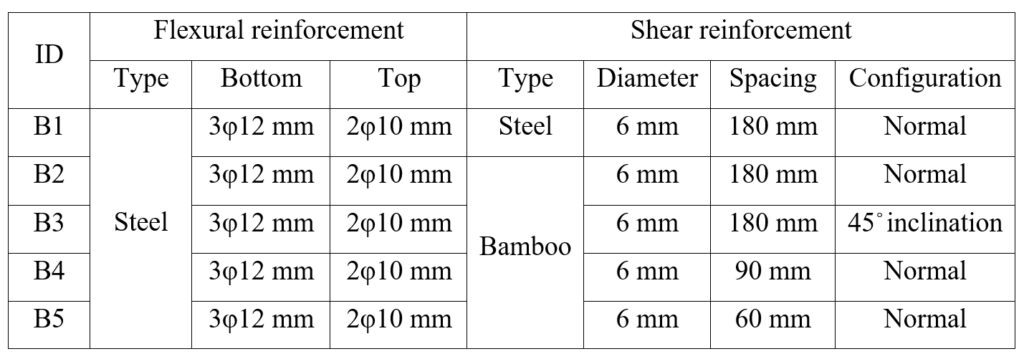
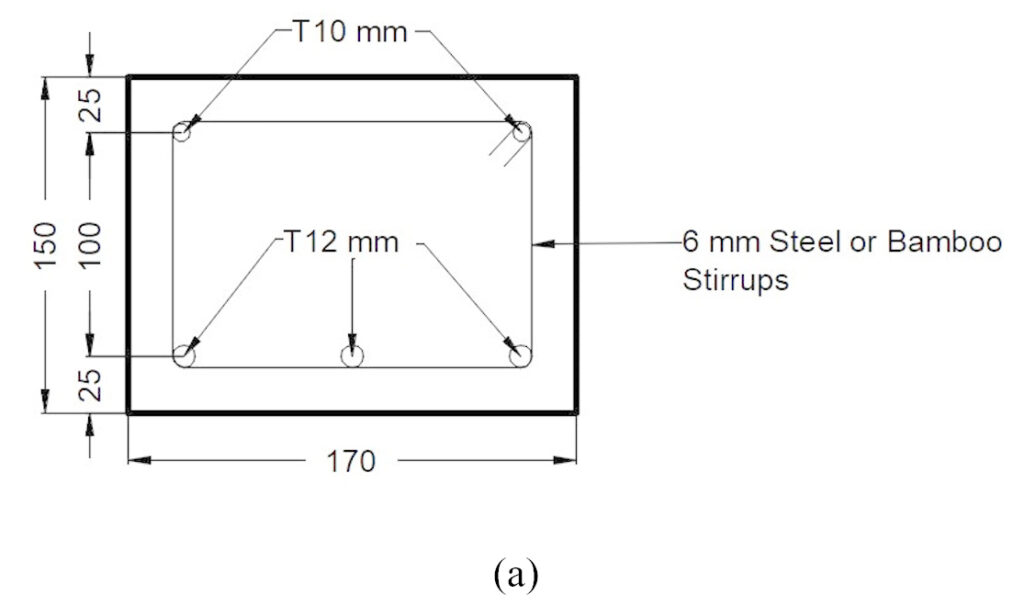
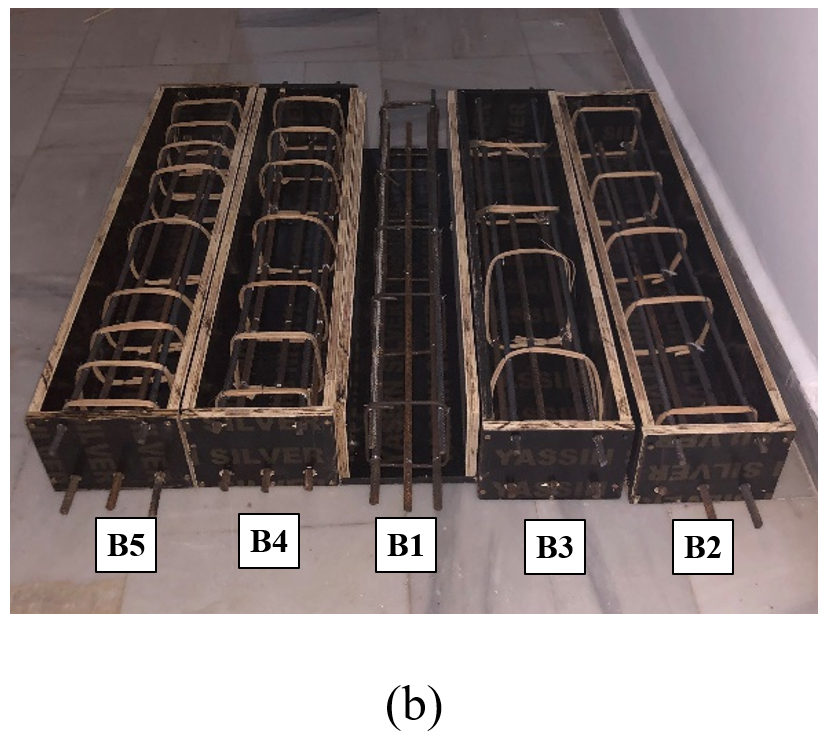
Figure 2. (a) Reinforced concrete beams dimensions and reinforcement (dimensions in mm), (b) Beams inside timber molds before casting.
The compressive strength of the concrete mixture was determined in accordance to BS EN 12390-3 at 7, 14, and 28 days of curing. At each age, three concrete cylinders were tested, and the average value was reported.
Four-points bending test was performed for the beams after 28 days of curing. An increasing load was applied on the beams. Two steel rollers were used to transfer the load to the beams from a steel I-section beam that in turn transferred the load from the testing machine. The full test setup is shown in (Figure 3). While loading, the central deflection was automatically recorded by the machine. The machine was stopped at loads 32, 64, and 96 KN to measure the strain distribution at predefined positions, 20, 40, 110 and 130mm from the top face as shown in (Figure 4). Two demountable mechanical strain gauge (DEMEC) discs were affixed onto the beam’s surface to assess the strain at specific locations using a mechanical strain gauge. The strain is determined by calculating the elongation between the two DEMEC points, divided by the initial spacing of 200 mm between them. A similar procedure was reported in literature (Manikandan et al. 2015, Khatib et al. 2019, Bawab et al. 2021). Loading was then resumed until failure.
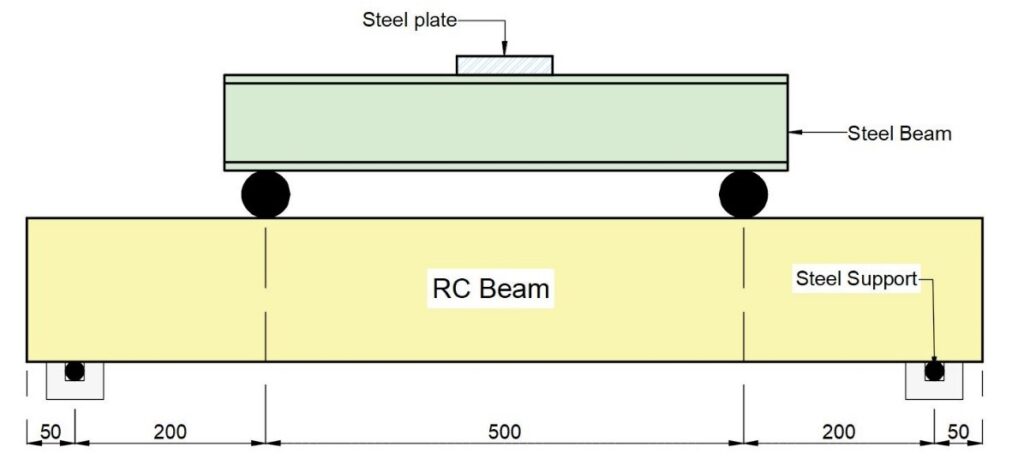
Figure 3. Four point bending test setup (dimensions in mm).

Figure 4. DEMEC points positions for strain distribution.
Numerical analysis was conducted on the five beams using ABAQUS 6.14 finite element software (Temsah et al. 2021, Jahami et al. 2021). The concrete body was modeled using 8-node linear brick elements with a mesh size of 1 cm, which was determined after conducting a mesh sensitivity analysis. The steel rebars and bamboo strips were modeled as 2-node linear 3-D truss elements. The contact between the steel supports and the concrete body was modeled as a “general contact” type, incorporating both “hard” normal contact and a tangential contact with a coefficient of friction of 0.7 between steel and concrete.
In addition, the cylindrical supports and loading rods were modeled as rigid bodies due to their significantly higher stiffness compared to the concrete body in contact (Temsah et al. 2018). It was assumed that all reinforcements were fully embedded inside the concrete body. For further information and visual representation of the beam modeling, please refer to (Figure 5).
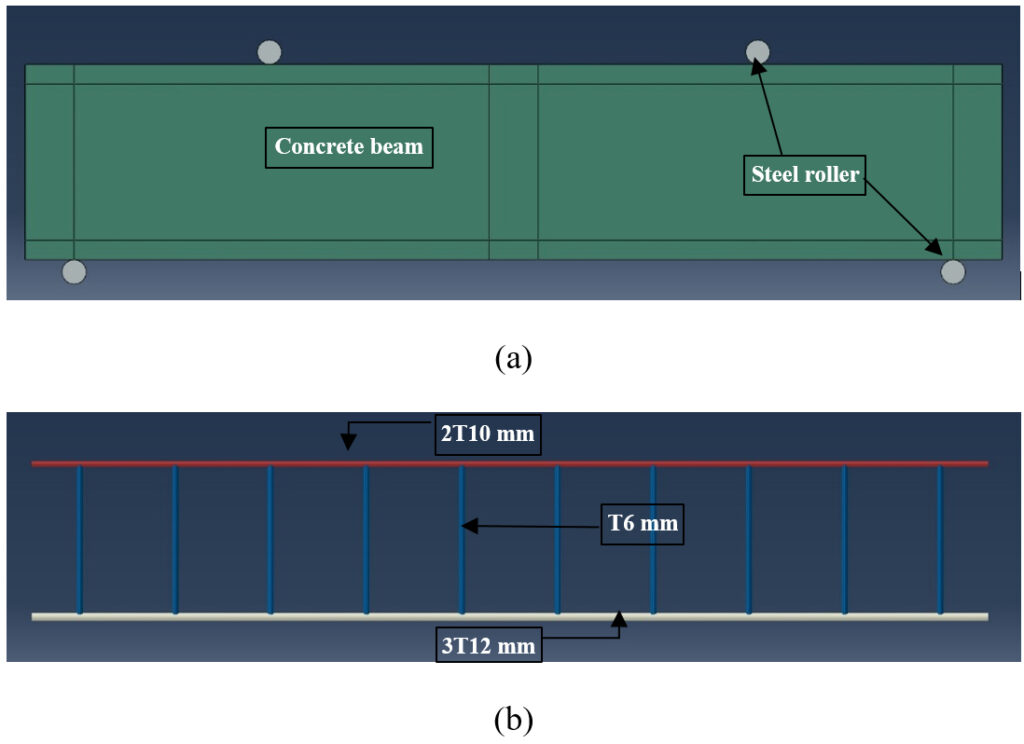
Figure 5. Software modeling of the (a) beam and (b) reinforcement.
Concrete material was defined using the built-in concrete damage plasticity (CDP) model, which accurately captures the nonlinear behavior of concrete under various loading conditions. The CDP model takes into account the damage accumulation and plastic deformation of the concrete material. The main parameters required by the CDP method, such as the tensile strength, compressive strength, Elasticity modulus, and dilation angle, are presented in (Table 3). These parameters were carefully selected based on experimental data and previous studies to ensure the accuracy of the numerical analysis (Temsah et al. 2021, Jahami et al. 2021).
On the other hand, steel rebars and bamboo strips were modeled as elastic-perfectly plastic materials, as they exhibit linear elastic behavior until reaching their yield point, followed by plastic deformation. (Table 4) provides the relevant properties for steel and bamboo materials, including the Young’s modulus, yield strength, and plastic strain. These properties were defined to accurately represent the mechanical response of steel and bamboo within the numerical model.
By considering the appropriate material models and defining their corresponding parameters, the numerical analysis aimed to capture the realistic behavior of the composite beam system, accounting for the nonlinear response of concrete while representing the elastic-plastic behavior of steel and bamboo materials.
Table 3. CDP parameters adopted in modeling

Table 4. Elastic-perfect plastic parameters for steel and bamboo materials

(Figure 6) illustrates the noteworthy progress in compressive strength observed in the concrete mixture over the curing periods of 7, 14, and 28 days. As the curing time increased, there was a notable enhancement in the compressive strength values. At 7 days of curing, the concrete exhibited a compressive strength of 13 MPa, which further improved to 16.3 MPa after 14 days of curing. The most substantial gain was observed at the 28-day mark, where the compressive strength reached an impressive value of 24.5 MPa. These results demonstrate the progressive development and maturation of the concrete mixture over time.
Notably, the achieved compressive strength at 28 days satisfies the minimum requirement for structural concrete as prescribed by the ACI 318 standard, which mandates a compressive strength of at least 21 MPa. This finding indicates that the concrete mixture under investigation possesses sufficient strength to meet the structural demands and can confidently be employed in various construction applications. It is worth highlighting that surpassing the minimum requirement demonstrates the excellent performance and durability potential of the concrete mixture, providing an added advantage in terms of structural integrity and long-term stability.

Figure 6. Compressive strength of the concrete mixture.
In (Figure 7), the load-deflection curve for beams B1-B5 at 28 days of curing is depicted, providing valuable insights into their structural behavior. Initially, all beams exhibited a linear curve, indicative of elastic deformation, until the occurrence of the first crack. Following the initial crack, the curve maintained linearity; however, the slope differed compared to the pre-cracking phase. This linear behavior persisted until the beams reached their maximum carrying load capacity. At this point, the concrete experienced crushing, leading to a brittle shear failure in all the beams under investigation.
Analyzing the maximum deflection of the beams equipped with bamboo strip shear reinforcement (B2-B5), it was observed that they exhibited a maximum displacement ranging between 3 and 3.8 mm. In contrast, beam B1, reinforced with steel, exceeded this value and reached a maximum deflection of 4.4 mm. These findings suggest that the inclusion of bamboo strips as shear reinforcement resulted in a more brittle behavior of the reinforced concrete beams. The bamboo strips, although contributing to the overall strength, demonstrated a reduced capacity to accommodate flexural deformations, ultimately leading to a stiffer response and a more abrupt failure mode.
Furthermore, examining the effect of varying the spacing of bamboo strip shear reinforcement on the maximum displacement of beams B2-B5, it was observed that the change had only a marginal impact. The maximum deflection values remained relatively consistent across the different beam configurations, indicating that altering the spacing of the bamboo strips within the studied range did not significantly affect the overall structural response in terms of deflection.
These findings provide valuable insights into the performance and behavior of bamboo strip shear reinforcement in reinforced concrete beams. It highlights the need for careful consideration and evaluation when utilizing bamboo as a substitute for traditional steel reinforcement, as the resulting structural response may exhibit more brittle characteristics. Future research could focus on optimizing the design and arrangement of bamboo strip reinforcement to enhance the flexibility and ductility of the beams, ultimately leading to improved structural performance and resilience.

Figure 7. Load-deflection curve of beams B1-B5.
The maximum load carrying capacity of the beams ranged between 116 and 178 KN. Reducing the spacing of the shear reinforcement largely contributed to the increase of the load carrying capacity of the beams despite using bamboo strips as an alternative. An increase of 30% in the maximum load when using Bamboo links instead of steel links (B1 and B2). However, further decrease in the spacing did not have a remarkable impact. In addition, comparing B2 and B3 having the same spacing (180 mm) but different configuration of the bamboo strips, the 45֯ inclination caused a noticeable increase in the maximum load, from 155 to 167 KN. The maximum shear capacity of the beams is detailed in (Figure 8) and was calculated by dividing the load capacity over two (half for each support).

Figure 8. Shear capacity of beams B1-B5.
(Figures 9(a-c)) provide insightful visualizations of the strain distribution within beams B1-B5 at various locations (20, 40, 110, 130 mm from the bottom face of the beam) under different load levels (32, 64, 96 KN). As expected, the bottom zone of the beams experiences tensile strain (positive strain), while the upper zone undergoes compressive strain (negative strain). Additionally, it is observed that larger loads result in greater strains across the beams.
A consistent trend is noticeable among all beams at every load level, where Beam B1 exhibits the largest deformation, while Beam B3 displays the least deformation. This indicates that the characteristics of each beam, such as the type of reinforcement or arrangement of materials, contribute to its overall structural response. The substantial tensile strains observed in the beams correspond to significant displacements, as demonstrated in (Figure 9).
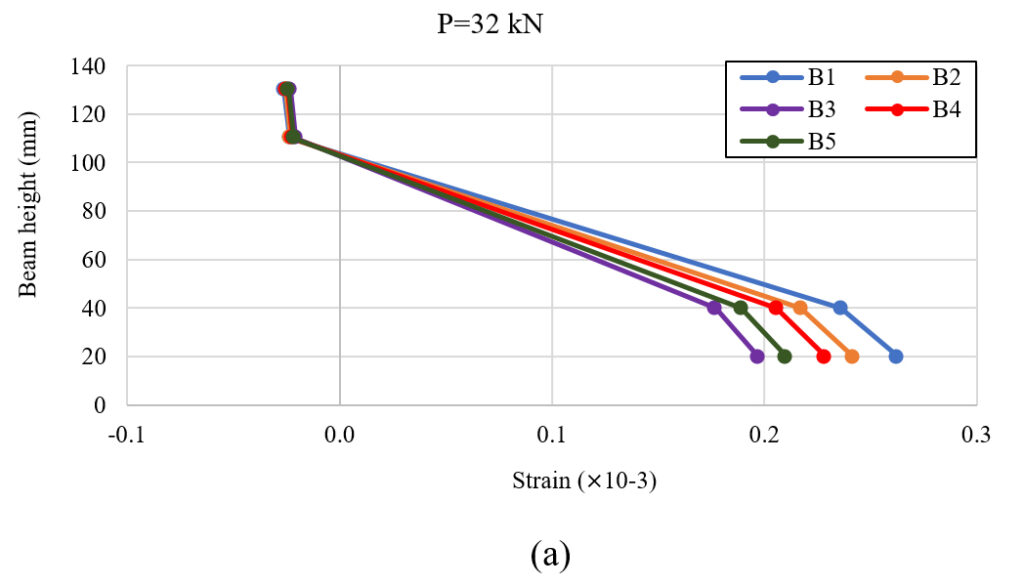

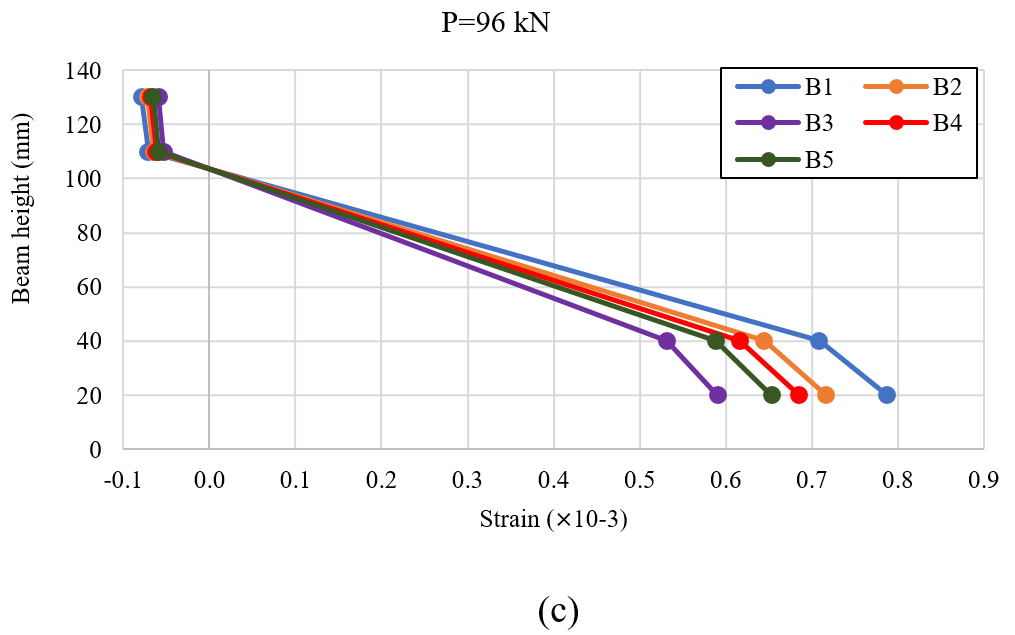
Figure 9. Strain distribution plots at (a) 32 kN, (b) 64 kN, (c) 96 kN
(Figures 10(a-e)) provide a comprehensive depiction of the failure mode and crack propagation observed in beams B1-B5. The examination of these figures revealed the presence of both flexural and shear cracks in all beams. The shear cracks primarily initiated near the supports and exhibited their widest extent at the bottom surface of the beams. On the other hand, the flexural cracks originated in the tensile zone and propagated vertically upward, with their maximum width also observed at the bottom of the beams.
Upon comparing the failure modes of beams B1 and B5, a notable observation emerges. As the shear capacity of the beam increased, there was a visible increase in the number of flexural cracks observed. This comparison highlights the influence of shear capacity on the structural response of the beams and the resulting crack patterns.
Despite their slight differences in shear reinforcement or design details, all beams exhibited similar crack propagation behavior. This finding suggests a consistent failure mechanism in which the beams experienced a brittle shear failure. The occurrence of brittle failure mode is indicative of limited ductility and reduced energy dissipation capacity within the beams.
The comprehensive analysis of the failure mode and crack propagation in beams B1-B5 contributes to a better understanding of the structural behavior and performance of the reinforced concrete beams under consideration. The observed crack patterns and failure modes can serve as valuable information for further design improvements and engineering interventions aimed at enhancing the ductility and overall resilience of concrete structures. Future research could focus on exploring innovative reinforcement techniques or modified beam designs to mitigate the occurrence of brittle failure and promote more desirable crack patterns, thereby improving the structural performance and durability of reinforced concrete beams.
(Figures 11(a-e)) provide a comprehensive comparison between the experimental load-deflection curves and the numerical simulations performed using ABAQUS 6.14 for beams B1-B5, respectively. The results demonstrate that the software exhibits a commendable level of reliability in predicting the load-deflection behavior of the beams, irrespective of their respective reinforcement configurations. The numerical simulations closely match the experimental curves, exhibiting similar trends from the initial loading stages until failure.
These findings align with similar studies reported elsewhere (Bawab et al. 2021, Khatib et al. 2020, Khatib et al. 2021), further validating the accuracy and consistency of the software in capturing the structural response of reinforced concrete beams.
However, it is important to note that the software tends to slightly underestimate the load carrying capacity of the beams, as observed in all cases. Conversely, the maximum deflection is often overestimated by the software, particularly for beams B3 and B5. This discrepancy may be attributed to the more brittle failure mode induced by the beams containing bamboo shear reinforcement, as well as the assumption of perfectly plastic behavior assigned to both steel and bamboo materials within the numerical model.
Moving on to (Figures 12(a-e)), the crack patterns generated by the software for beams B1-B5 are displayed. The crack patterns closely resemble those observed experimentally, further indicating the accuracy of the numerical simulations. The presence of multiple diagonal cracks concentrated near the supports indicates a shear failure mechanism. Additionally, for beams subjected to higher loads, the flexural cracks become more prominent, originating from the bottom face of the beam and propagating upwards. Consequently, the software provides further insight, revealing that beams B1-B3 exhibit fewer flexural cracks due to their earlier shear failure, while beams B4 and B5, carrying higher loads, exhibit more flexural cracks prior to experiencing shear failure.

Figure 10. Crack propagation for beams (a) B1, (b) B2, (c) B3, (d) B4, and (e) B5
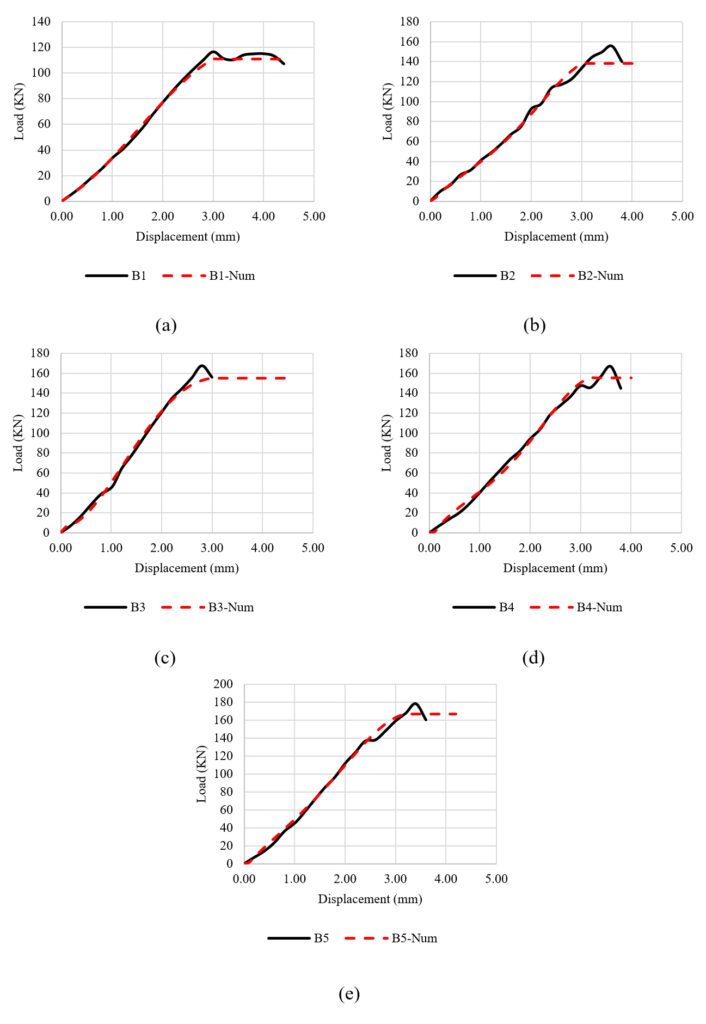
Figure 11. Numerical vs. experimental load-deflection curves for beams (a) B1, (b) B2, (c) B3, (d) B4, and (e) B5

Figure 12. Crack pattern generated by the software for beams (a) B1, (b) B2, (c) B3, (d) B4, and (e) B5
In this study, an assessment was conducted on the shear behavior of five reinforced concrete (RC) beams incorporating bamboo strips as shear reinforcement, considering different spacing and configurations. The beams were constructed using structural concrete with a compressive strength of 25 MPa. The experimental program involved subjecting the beams to a four-point bending test to evaluate their load-deflection curves, crack patterns, and strain distribution. Additionally, numerical analysis was performed to validate and predict the behavior of the beams. The key findings of this study can be summarized as follows:
Overall, this study provides valuable insights into the use of bamboo strips as shear reinforcement in RC beams. The results highlight the enhanced load carrying capacity, the influence of inclined bamboo strips, the impact of spacing on shear capacity and damage patterns, and the successful validation of the numerical model. These findings contribute to the knowledge base for designing and optimizing RC structures incorporating bamboo strips as a sustainable alternative to traditional steel reinforcement.
Cite: Jahami, A., Khatib, J., & Bawab, J. (2023). An Experimental and Numerical Evaluation of the Structural Performance of Concrete Beams Containing Bamboo Shear Reinforcement. Steps For Civil, Constructions and Environmental Engineering, 1(1), 1–9. https://doi.org/10.61706/120111
Copyright: © 2023 by the authors. Licensee SSG, Dubai, UAE.
This article is an open access article distributed under the terms and conditions of the Creative Commons Attribution (CC BY-NC-ND 4.0) license (http://creativecommons.org/licenses/by-nc-nd/4.0/).






An independent academic publisher with an editorial team including many of the top researchers in the world. SSG publishes research, review, and case report articles in double-blind, peer-reviewed, open access scientific and academic journals.
Copyright © 2023 Scientific Steps International Publishing Services LLC (Dubai – United Arab Emirates)